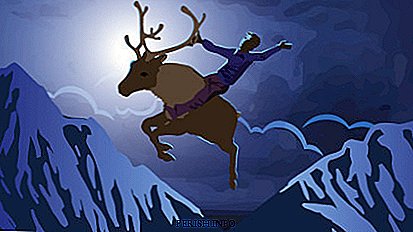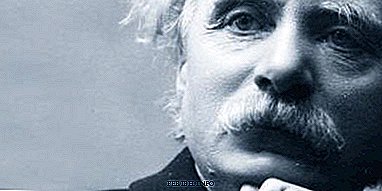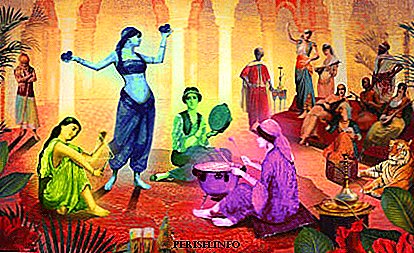E. Grieg "Peer Gunt"

Musical accompaniment to a theatrical performance, and subsequently two suites “Peer Gynt”, are rightfully included in the golden collection of masterpieces of world art. The collaboration of the famous poet and playwright Henrik Ibsen with Edward Grieg brought to the world not only an amazing production, but also excellent music. You can learn the history of the creation of the composition, read interesting facts and plot, listen to the compositions performed by the best musicians of our time, and also study the musical characteristics of the most famous numbers on our page.
History of creation
In 1870, the world learned a new writer. Henrik Ibsen, who was born and grew up in Norway, became famous throughout the world thanks to the composing of two plays, Brandt and Peer Gynt. In these plays are contrasted images of man and his aspirations in life. One of the heroes tries to find the true life path, while the other literally runs away from problems and does not want to change anything. Peer Gynt, as a literary character, was a psychological model that was quite relevant for all times. He did not want to change himself, did not want to look for meaning, he wanted to be accepted as he is.
Work on the play continued throughout 1867. In the autumn, when the writer was in Sorrento, he finally completed work on an essay consisting of 5 acts and not dividing into pictures. The hero was taken from the folklore of Norway, while Ibsen tried to fill him with the characteristic qualities of a romance who is in constant wanderings, searches, and misses a truly important feeling in his life. Nevertheless, courage, courage and desire to commit desperate acts can be considered the main qualities of Peer Gunt.
At the end of 1873, the edition of the work for the production began. Ibsen was very attentive to every detail, music played an especially important role for him. The writer thought that no one would be better able to cope with the task of composing such musical accompaniment that could convey the atmosphere of action than Edward Grieg. In those days, the composer was known to the whole world. Before that, Grieg wrote romances to Ibsen more than once, so the musician willingly agreed to cooperate. At the same time, the writer knew exactly what kind of music he wanted for a particular act.

It is quite difficult for a creative person who has his own view and presentation to write music, adhering to strict frameworks and copyright instructions. Perhaps it is for this reason that work on writing music has been going on for a long time. Lyrical music using Norwegian folk motifs was completed first, the rest of the dance was difficult. In the first term of the production, the work was not completed; in the fall, the composer went on a trip to Europe, but there he continued to actively compose new numbers and orchestrate the ready ones. In the spring of 1875 the score was fully completed.
The premiere of the play took place in February next year, the success was overwhelming. During the season the play was staged 36 times. Ibsen and Grieg are a creative union that has managed to create a truly interesting theatrical performance.
10 years later, the second premiere took place in Copenhagen, for which the composer completely reordered the musical material. Again, success and positive reviews, both theater and music critics.
In the future, the composer created two amazing suites from the most bright and independent numbers. The first suite op.46 was completely completed in 1888, the second suite was composed three years later. The music was recognizable, so many conductors of that time instantly included works in their own repertoire. Today, music does not lose its own relevance, it still reflects the national Norwegian flavor, typical of the work of Edvard Grieg.
Plot

Henrik Ibsen skillfully interweaves Scandinavian myths and legends into the storyline, so history acquires the features of a fairy tale with morality. Peer Gynt is an unusual boy from the village, the son of a man who was inherited but could not keep the money and went bankrupt. Everything that was lost by Father Peer Gynt wants to recover, he constantly boasts that he will become just as rich, but his actions are not supported by action and people laugh at him. The hero gets involved in a fight with a blacksmith. At the wedding in Hagsted, he meets Solveig, kidnaps the bride Ingrid. Hunt opens on Peer Gynt and is wanted, but he goes to the mountains with three shepherds. Trolls surround the kid, their king conjures him "always be pleased with yourself." Solveig remains to live in their hut on the outskirts of the forest.
Time passes, the mother of Peer Gunt Oze dies. Leaving his father's house and Solveig, the hero sets off for the blue sea. He is waiting for adventure in different countries. Throughout his life, the hero traveled, changed professions, until he was old. All this time, faithful Solveig waited and believed that Peer Gunt would return. She prayed for him, and her prayer protected and saved the traveler. After so many years, Per Gugt returns to his native place and meets the one that spent her whole life in anticipation. For her, he will always remain himself.
Interesting Facts
- From the music to the play in the future, the composer created two suites, they included four numbers of twenty-three compositions.
- In 2015, the ballet "Peer Gynt" in 2 acts was set to music. The libretto was compiled by Edward Klug.
- While composing the play, the writer turned to Russian Norwegian folklore. So, the name of the literary character was borrowed from a collection of fairy tales collected by Peter Christense Asbjørnson and Jørgen Mu.
- For staging in Copenhagen, Edvard Grieg completely remade the orchestration.
- The full score consists of 23 numbers, including dance inserts and introductions to each act.
Content
The music for the play "Peer Gunt" is colorful and colorful. The individual numbers that are included in the suites are complete musical compositions. In each room, the atmosphere, thought out to the smallest detail, is transmitted, the composer was able to illustrate the originality of other countries, using a number of professional techniques characteristic of music of other nationalities. Consider the musical characteristics of the most famous compositions.
Morning

With the rising of the sun in the heart to the one who believes comes hope for the best. New day lets start everything differently. The question arises: is it possible to change the world without changing yourself? As in the testament of the mountain king and the trolls: "always be pleased with yourself?". And how many obstacles need to be overcome in order to understand that true happiness is always closer than it seems, and there is no need to go for three nine lands to find it.
The nature of Norway, a sense of space gives the listener a sense of calm. All storms will fade away by themselves, obstacles will be overcome, if only there was one who believes and waits, no matter what.
The expressive means addressed by the composer are pentatonic, pure transparent harmony and the timbres of the flute, the oboe. All this creates pastorality, landscape and picturesque. The rest of the morning nature is what you need to come to harmony.
"Morning" (listen)
Death oze
Incredibly lyrical and tragic number. In it, Grieg manages to convey a whole palette of feelings from concentration to despair and an unrestrained impulse to realize a long journey. Gradually, the emotional temperature increases and reaches a climax using the choral, as a symbol of death and extremity of the human path. But suddenly there is silence, alternating with quiet and surprisingly light music. String instruments allow you to convey the warmth of the moment of farewell of the mother and son. Only chromatic intonation, as symbols of the disease, darkens the musical material. The writing is amazing restraint and conciseness, and at the same time, sensuality and sublime lyrics.
Anitra's dance
An illustration of the scene of dancing Anitra, the sheikh's daughter, is accompanied by an original dance. The number is contrasted compared to the previous scenes associated with the Norwegian flavor. The flexibility, grace of the melody, and its oriental beauty emphasize the oriental image of the heroine, combining captivatingness and deceit. The composer uses ringing trills as decorations.
"Dance of Anitra" (listen)
In the cave of the mountain king
The gloomy realm of Dovra grandfather is voiced in the timbres of low strings and bassoon. Gradually, the sonority gains more saturation and dynamics. The melody is a bit primitive, reminiscent of a mixture of Scottish motifs and a march. With each beat, it is gaining momentum, which leads to a climax building. The whole orchestra rumbles and amazes with its power and magnificent fullness of sound. Amazing orchestration. Percussion instruments stand out in particular, creating not only a rhythmic step, but also a dynamic avalanche that completes the first suite.
"In the cave of the mountain king" (listen)
Complaint ingrid
A bright, multi-featured sketch opens with a small episode at a rapid pace. The use of all tools, with the exception of heavy copper allows you to immediately attract attention. This is the anger of the abducted bride. The theme, which is directly related to the Norwegian folklore, namely the wedding folk dance, continues the miniature. Second intonations are the image of the bride's cry, continue with a drawn-out melody and end with the furious material of the entry.
Arabic dance
The heat of the Arabian desert. Peer Gunt wanders through the quicksand. He hears a broken melody in the performance of high wind instruments. The precise rhythm of the big drum makes you literally start dancing. Gradually, the winding melody turns into a string of stringed instruments, recreating the orientality of Eastern music.

The Return of Peer Gynt
The years of wandering imposed a visible mark on Peer Gynt, and so he decided to go back. But here, too, difficulties await him. The sea is restless, the elements are raging, the waves are rising higher and higher. This natural disaster is used as an allegory of personal tragedy. Life is lived in vain, wandering brought nothing but facial wrinkles. The number can be considered not only a semantic, but also a tragic climax.
Song solveig
Lyrical song Solveig completes the suite. Two met on the empty road after decades. They are no longer young, the years spare no one. But faithful Solveig always knew what Peer Gunt would wait for. Elegant, gentle music, filled with sincerity. In her image, the composer wants to embody the features of the motherland, and therefore uses a genuine folk melody. Purity, wisdom and poetry - that is what characterizes the heroine.
The use of music in the cinema
| Morning | Happiness (2017) |
| Australian Ninja (2017) | |
| Boys and girls (2017) | |
| Book of Life (2014) | |
| The Croods Family (2013) | |
| In the cave of the mountain king | Merli (2016) |
| American family (2013) | |
| Agent Johnny English: Reload (2011) | |
| Social Network (2010) | |
| Death oze | Neruda (2016) |
| Trust (2016) | |
| Song solveig | Coals (2015) |
| Knight of Cups (2015) | |
| Anitra's dance | It's always sunny in Philadelphia (2012) |
| Ideal host (2010) | |
| She is a man (2006) |
The richness of images, stylistic diversity, the use of unusual artistic techniques make the music truly unique and inimitable. Edward Grieg succeeded in bringing musical images to life and emphasizing the characters spelled out by Henrik Ibsen. Skill and talent helped to raise theatrical music, giving it the right to independent existence.

Leave Your Comment